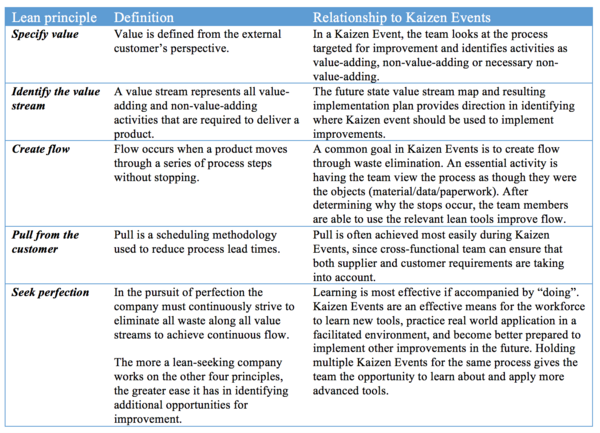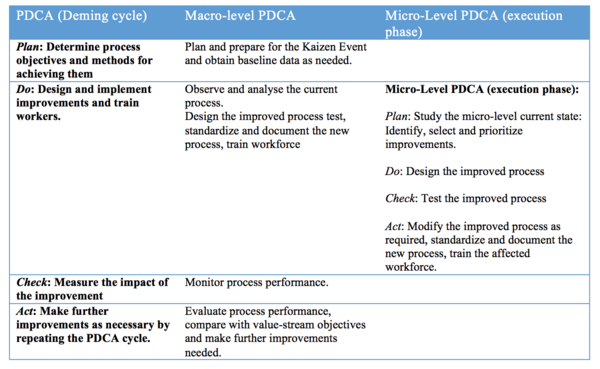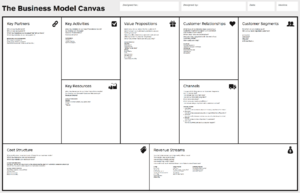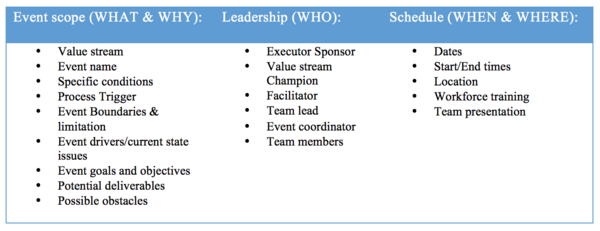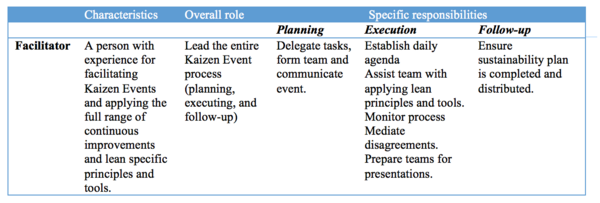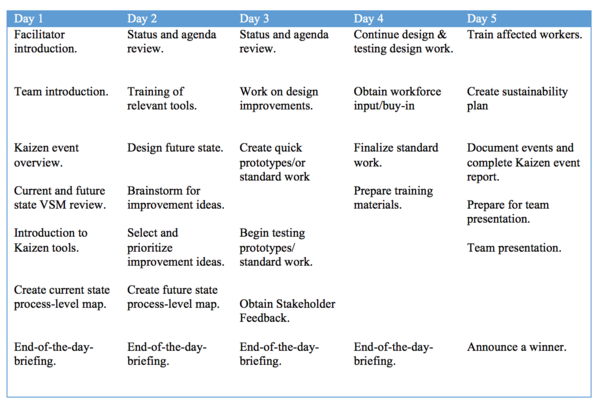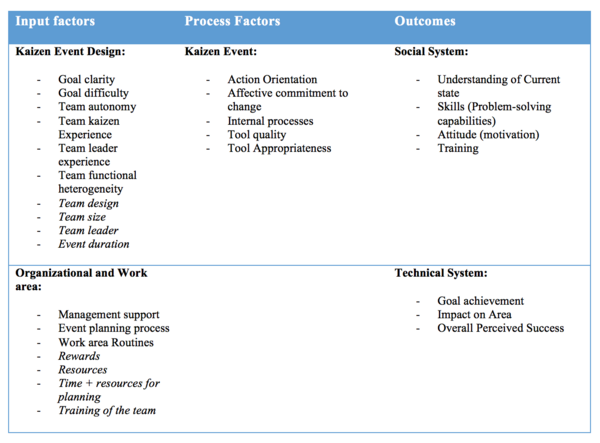Kaizen Event
Developed by Charlotte Krag Varslev-Pedersen
Summary: A Kaizen Event is a workshop in an organization where management invites employees to work together in cross-functional teams to identify and solve a problem in a short period of time. A Kaizen Event is different from other kinds of “collaborative workshops” since it is centered on a Lean thinking approach and uses general lean tools.
This article looks into how a Kaizen Event can be used as a managerial tool for problem-solving processes in a project. The article will introduce the term Kaizen Event relative to general Lean principles and the Kaizen concept in Lean thinking. The article will then give an overview of and a Guide to how a Kaizen Event should be carried out and what important things to consider when doing so.
The article states that Kaizen Events can be used as a bottom-up approach for rapid improvement and for problem solving beyond the context of lean manufacturing. It also stresses that a core benefit from carrying out Kaizen Events is creating motivation and problem-solving capabilities for the individual employees.
Keywords
Kaizen, Kaizen Event, Lean Thinking, Problem-solving, Cross-functional teams, Project Management, Lean Project Management.
Introduction to Kaizen Event
Kaizen vs. Kaizen Event in Lean thinking
Lean thinking a business strategy that aims for achieving a lean enterprise, meaning an organization that strives to reduce waste and non-value-adding effort by introducing the five basic lean principles (See section “Kaizen Events and Lean Principles”). “Kaizen” can be defined as a way of achieving this.
According to Lean thinking does the term Kaizen represent continuous incremental improvement, and it refers to a general way of thinking and behaving. Kaizen (http://en.wikipedia.org/wiki/Kaizen) should be practiced on a daily basis and it is about empowering and unleashing the creative power of people who actually do the work, in order to design more effective and efficient processes. This in order to spread lean thinking throughout the organization and teach the employees how to effectively solve problems as they arise (top-down approach). A Kaizen Event, on the other hand, is a formalized activity that an organization uses to achieve rapid and dramatic improvements (Kaikadu) and progressively shift the culture in an organization. Kaizen Events create a structured environment in which teams learn how to identify waste and apply specific lean tools to eliminate it. In this “learn-by-doing” environment, the teams become more comfortable with their authority to make improvements, and it is therefore referred to a bottom-up approach for making changes. Under the guidance of a skilled facilitator, a Kaizen Event can generate rapid results. This is however relying on the creative power of cross-functional teams to design and implement innovative ways to perform work [1].
Kaizen Event definition
A Kaizen Event can be defined as:
"A focused and structured improvement project, using a dedicated cross-functional team to improve a targeted work area, with specific goals, in an accelerated timeframe." [2]
This definition can however be rather abstract and in the context of this article is a good reference the term “workshop” that can be defined as:
”A brief, intensive course of education for a small group, emphasizing interaction and practical problem solving.” [3]
Therefore are Kaizen Events also referred to as Kaizen workshops (or Kaizen Blitz or blitzen). This article will use the term Kaizen Event representing a five-day event that focuses on problem solving using the Lean thinking approach [4]. All the activities involved in conducting a Kaizen Event will in this article be referred to as the Kaizen Event Process.
Kaizen Event & Lean principles
The five basic Lean principles are:
- Specify value.
- Identify the value stream.
- Create flow.
- Pull from customer.
- Seek continuous perfection.
The Kaizen concept belongs to the Seek perfection lean-principle because the idea of achieving perfection is an on-going process that involves continuous improvements. Whereas a Kaizen Event focus more on a problem in all or one part of the other four lean principles [1].
In Lean thinking value is specified according to the organizations customers. Identifying what is and what is not a value-adding element or activity is key in a Kaizen Event. Current relations and flow between the elements are thus mapped in order to understand where to make improvements. When making future improvement it is vital to take the customer requirements into account. In a Kaizen Event this is ensured by facilitated the cross-functional teams, since each employee represent an important understanding of the customer need. In a Kaizen Event the area of improvement is often found in one of the four areas of customer value, breakdowns in the value stream or from the pull from customer requirements. Activities are often targeted towards one of these areas, but the key in a Kaizen event is to get and holistic understanding of the elements in order to make the right improvement [1].
The relationship between the five lean principles and Kaizen Event is explained in Table 1 [1].
Increasing use of Kaizen Events
Kaizen Events are often associated with lean production and lean manufacturing [5], where Kaizen Events can result in improvements in technical system outcomes, such as lead time, work-in-process inventory, and productivity. It has however also gained a reputation for providing social system outcomes, such as helping employees develop new problem-solving capabilities and increased motivation to participate in future improvement activities [6]. Given this potential of Kaizen Events for producing rapid improvement in both technical and social system outcomes, many organizations appear to be increasing their use of Kaizen Events [7]. Kaizen Events are an increasingly common organizational improvement mechanism aimed at work area transformation and employee development [2] and it is therefore also seen as managerial tool. This increased focus has also resulted in an expansion of the use of Kaizen Events. Several companies has also started using the frame of the Kaizen Event as a problem-solving tool for concrete problems related to other areas in the company such as the R&D department focusing on problem solving in product development teams.
Imai Masaaki and Kaizen as a problem-solving process
According to one of the formulators of the Kaizen concept, Masaaki Imai, is the problem-solving capability one of its core elements:
”The starting point for improvement is to recognize the need. This comes from recognition of a problem. If no problem is recognized, there is no recognition of the need for improvement [..] Therefore, Kaizen emphasizes problem-awareness and provides clues for identifying problems.” [8]
Masaaki states that once a problem has been identified it must be solved and therefore does the concept of Kaizen also contain various problem-solving tools. Another core idea of the Kaizen concept is that all employees in the organization have the capability and the will to contribute to the continuous refinement and betterment of the existing activities [9]. Instead of seeking to control and measure the activities of the employee, the managers should act as coaches, supporting the improvement activities carried out by the employees in the kaizen teams. This behavior is facilitated in order to support a bottom-up approach where the individual employee has a say in the way problems are solved [9].
In his book “Kaizen - The Key to Japan’s Competitive Succes” from 1986 Massaki provides both analytical problem-solving tools based on attainable data, and more collaborative problem-solving tools based on verbal data. Today these methods are still valid and well recognized. They are used frequently in Kaizen Event in companies around the world, but should be carefully selected relative to the scope of the Kaizen event. See section "Kaizen Event Tools" for further elaboration.
Masaaki also introduces the general lean principle tool called Quality Circles, that he also elaborates on. He calls his elaboration of this principle PDCA-circles, which is a common approach used in the context of Kaizen Events [10].
PDCA and Kaizen Events
Kaizen Events use the scientific approach of plan-do-check-act PDCA (http://en.wikipedia.org/wiki/PDCA), one of the cornerstones of the Toyota Production System (http://en.wikipedia.org/wiki/Toyota_Production_System). The PDCA improvement cycle focus on seeking perfection rather than waiting for perfection. The PDCA cycle is present at two levels a Kaizen Event. The three phases of a Kaizen Event – planning, execution and follow-up (macro-level). During the Event itself (the execution phase) lies a micro PDCA cycle, see Table 2 [1].
This PDCA cycle provides iterative loops in the Kaizen Event that makes the participants go over a solution several times and forces the participants to think all the way to the implementation phase several times. This iterative process is one of the forces in a Kaizen Event and the quick loops done in an accelerated timeframe is another aspect that differentiates Kaizen Events from other workshops types.
Guide for a Kaizen Event process
Based on a literature study a generic framework for a Kaizen Event process is outlined and includes the following steps:
- Planning (“Plan”)
- Executing (“Do” & “Check” and iterative circles of PDCA)
- Follow-up & Implementation plan (“Act”)
1. PLANNING
In order to plan a forthcoming Kaizen Event should the basic questions of WHAT, WHY, WHO and WHERE be considered and answered. This can be categorized into Scope, Leadership and participants and Schedule and the following activities should be done in regards to each category [1]:
SCOPE:
- Select area of investigation
- Select problem for improvement
- Prepare the area/scope
- Gather needed supplies and equipment
- Gather data and background information needed
LEADERSHIP & PARTICIPANTS:
- Select Kaizen Event facilitator – will you use and internal or external consultant?
- Select Kaizen team participants, define the team and team leader
SCHEDULE:
- Communicate the plans for the Kaizen Event to the entire organization
- Schedule the event
Additional important things to consider according to scope, leadership and schedule are listed in Table 3 [1].
Since a Kaizen Event is dependent on the people participating in it, is the role of the Kaizen Event facilitator and the way the participants of the Kaizen Team are selected is especially important.
1.2. Kaizen Event Facilitator (sensei)
Through the process of a Kaizen Event, the facilitator teaches the team members how to think in lean terms and how to use the lean tools selected for the event. The role of the facilitator is to keep the team on track, help maintain momentum and assist the team in overcoming obstacles. The facilitators role relative to the different steps are listed in Table 4 [1].
1.3. Kaizen Team formation
A Kaizen Event team represents a specific type of team—a short-duration dedicated project team [11]. The composition of a Kaizen Event team must therefore be structured to achieve the following desired outcomes [1]:
- Short-term performance improvements results
- Long-term improvement of cultural transformation
- Teamwork critical elements in creating a continuous-improvement culture
- Good mix of individual from across functional units in the organization
The above should be considered relative the scope of the Kaizen Event – including the context of the problem that should solved.
Another core idea of the Kaizen concept is that many problem-solving situations call for collaboration among people from different departments. When doing a Kaizen Event it is therefore believed that an important feature of the design approach is to involve people from different backgrounds because it will make it more effective to solve cross-functional problems [8].
2. EXECUTION
The execution of the Kaizen Event should be based on the preparations in the planning phase, and during a Kaizen Event it is recommended to go through the following activities [1] [7]:
- 0. Orientation
- Introduce the team and assign roles
- Introduce the workshop objectives and procedures
- Distribute team supply kits and resources
- Conduct needed training and set ground rules
- 1. Understand the current situation
- If possible, observe the selected area and gather data
- Review the value stream map
- Set up areas for improvements
- 2. Make improvements
- Documentation and understanding of the current state
- Identification of opportunities for improvement
- Improvement selection & prioritizing;
- Develop improvements ideas
- Test ideas and implement the new plan
- 3. Follow-up preparation
- Results presentation
- Documentation of an action item list for follow-up activities
An example of a five-day agenda for a Kaizen Event can be seen in Table 5 [1].
2.1. Kaizen Event tools
The tools used in a Kaizen Event should be carefully selected relative the desired outcome of the Kaizen event and the teams participating in it. Moreover should the tools be selected to support the “Current State Analysis” and the process to “Make Improvement”.
2.1.1. Current State Analysis:
This part of the Kaizen Event is about understanding the “Current State”. There are several ways of identifying and selecting what problem(s) to improve in a Kaizen Event. Often will the problem area for the current analysis be defined prior the execution of the event, but the main idea of conducting the current state analysis in cross-functional teams during the event is to understand the root-causes of the selected problem area and identify problem areas together. Tools from categories of analytical- and collaborative problem solving identification can be used to understand the current state.
2.1.2. Analytical tools:
These tools are based on easy measurable data and can be prepared prior the event.
- Histograms: A visual way of presenting data (http://da.wikipedia.org/wiki/Histogram).
- Control charts: Serve to detect abnormal trends with help from line graphs. (http://en.wikipedia.org/wiki/Control_chart).
- Scatter diagram: Two pieces of corresponding data are plotted so the relationships can be compared (http://en.wikipedia.org/wiki/Scatter_plot).
- Graphs: Visual representation of data.
- Checksheets: These are designed to tabulate the results through routine checking of the situation (http://en.wikipedia.org/wiki/Check_sheet).
- Pareto diagrams: Problems are diagrammed according to priority using a bar-graph format, and can for example rank occurrences in the order of frequency (http://en.wikipedia.org/wiki/Pareto_chart).
2.1.3. Collaborative tools:
These tools help participants work together to make diagrams that helps them understand and organize data.
- Relation diagrams: Clarifies interrelations of a complex situation (http://www.qimacros.com/quality-tools/relation/).
- Cause-and-effect diagram: Characteristics of a process or a problem are analyzed according to the factors that contribute to them. These diagrams are often referred to as “Fishbone” or Ishikawa (after its developer) (http://en.wikipedia.org/wiki/Ishikawa_diagram).
- Affinity diagram: A tool for organizing data from various media. Participants write down quotes or statements and these are grouped according to subject. (http://en.wikipedia.org/wiki/Affinity_diagram).
- Tree diagram: Interrelations of goals and measures (http://en.wikipedia.org/wiki/Tree_structure).
- Matrix diagram: Used to displaying quality requirements into counterpart characteristics.
- PDPC (process decision program chart): Decision program chart (http://en.wikipedia.org/wiki/Process_decision_program_chart).
- Arrow diagram: A network diagramming technique in which activities are represented by arrows. (http://en.wikipedia.org/wiki/Arrow_diagramming_method).
- PERT - Program Evaluation and Review Technique (http://en.wikipedia.org/wiki/Program_evaluation_and_review_technique).
- CPM - Critical Path Method (http://en.wikipedia.org/wiki/Critical_path_method).
The above represents the "traditional" lean tools that also includes the lean production tools, such as standardwork, 5S (http://en.wikipedia.org/wiki/5S_(methodology)). In recent literature are Value Stream Mapping (http://en.wikipedia.org/wiki/Value_stream_mapping) and Cause-and-effect diagram referred to as the main fundamental tools for the Root-Cause-Analysis – RCA tools [4]: Value Stream Mapping is used to identify all relevant functions and individuals, to understand about the process flow and to document the current process of performance. On the other hand does a Cause-and-effect diagram identify the characteristics of a process or a problem according to the factors that contribute to them. It also serves as a visual tool that supports brainstorming and document potential causes and sub-causes for an undesired effect or outcome. In this way does it provide a structure to a team’s brainstorming [4].
2.1.2. Make improvements:
This part of the Kaizen Event focuses the process of generating aggressive outcomes:
- Start by reviewing the Current State Analysis
- Stimulate innovative thinking (initiated by “ice breaker” exercise)
- Provide improvement tools training
- Conduct brainstorming session to generate improvement ideas
- Evaluate and Prioritize improvement options
- Test ideas, iterate and implement the new plan
- The brainstorm session: There are several ways to conduct brainstorming. The most important thing is to set up common rules in the team, to avoid judgment, and to make team members confident to suggest wild ideas and make it okay to build on ideas from others. Principles of various other fields can be applied in this section, and should be chosen relative to the scope of the Kaizen.
- Affinity diagram: It is a tool commonly used to sort a large numbers of ideas stemming from brainstorming into groups, based on their natural relationships.
- Quick prototyping: The ideas from the brainstorming should be tested by doing simple prototypes that could be made within a couple of hours with simple materials, such as cardboard. This is done to quickly test, verify and iterate on the ideas. In the context of manufacturing this could be done by outlining the new layout of the workshop with duct tape and in product development this could be done by building simple models from cardboard.
3. FOLLOW-UP & IMPLEMENTING IMPROVEMENTS
The follow-up phase is essential for implementing the improvement that we suggested in the Kaizen Event, and after a Kaizen Event it is recommended to go through the following activities [4]:
- 1. Present the results of the Kaizen Event to the organization
- Prepare presentation
- Present the results and display results in a central area for people to read
- Celebrate the completion of the workshop
- 2. Follow-up
- Assign follow-up tasks and make sure they are completed.
- Prepare and conduct training
- Document and continue to tracks results.
- Consider next steps.
They key question that the Kaizen team must answer when considering its implementation strategy is what key tasks should be assigned and to whom. Also it is important to consider the impact of change and how many people that will be affected of the desired changes [4]. To implement the improvement is a big challenge since it requires commitment by management and allocated resources. Masaaki also stresses that in order to consolidate the new level, however, the improvement must be standardized and consequently does Kaizen require standardization. The process for achieving this standardization should involve everyone the organization including both managers and workers [8].
Sum up of factors to consider in a Kaizen Event process
Critical factors of what to consider throughout the Kaizen Event process can be useful in order to achieve full potential of the time spend on the events [2]. An overview of Critical factors to consider can be seen in Table 6 [1].
- Guidelines: Even though the use of Kaizen Events are increasing does organizations currently lack guidelines for how to organize knowledge related to Kaizen Events in order to better understand recommended practices and to evaluate current practice [10].
- Goal clarity: The scope and goal clarity of the Kaizen Event is key for a successful outcome. Also should the selected tools fit to the scope of the event.
- Team dynamics: To obtain maximum impact on both employee’s attitude and problem-solving ability should organizations seek to maintain positive team dynamics, through the use of structured mechanisms such as team ground rules, ice breakers, training and charters. To increase the problem-solving capability should teams be allowed a high degree of autonomy and the individual employees should be able to see the relevance of participating. This could for example be from clearly describing the reasons for the event, and thereby demonstrating how the event will positively impact both individual and organizational interests [11].
- Support from management: Visible support from the top management essential, since it will help create a culture around rapid improvement changes. It will also be essential for getting the right amount of resources to go through with the follow-up & improvement activities.
Benefits
Understanding the current system: The starting point for a Kaizen Event is to analyze the current system. It is essential to have an in-depth understanding of the complexity of current state to be able to identify breakdowns, prioritize them and to suggest areas for improvement. This insight can also be useful for the everyday work of the employees, since they get a more holistic understanding of what they are working with.
Rapid improvements: One of the key elements in a Kaizen Event it the iterative activities that stems from the use of PCDA circle approach. Together with the accelerated timeframe for a Kaizen Event it is an effective way to provide results in a relatively short time.
Aggressive objectives: Kaizen Events can be used for working on more aggressive objectives than what is otherwise the focus in the daily work situation. Genuine support from the top management also creates space for thinking more creative than under otherwise restrictive financial frames. Kaizen events are out of synch with the daily rhythm and the five-day timeframe also induces rapid decisions and real-time buy-in.
Cross-functional teamwork & Problem solving The setup of cross-functional teams supports the positive attitude among the employees. Through a Kaizen Event, cross-functional teams learn how to make improvements in a methodological way. They learn how to apply specific improvement tools. Most importantly they learn how to work with one another to solve problems rapidly and in a highly effective way [1]. This has the potential to give motivation and enhanced job satisfaction for the employees since they feel that that their contributions are meaningful.
Empowering the workforce (bottom-up): The overall process of a Kaizen Event enable the managers to solve problems in the organization by empowering their employees to be the ones that provide the solutions. This article also especially stresses these non-measurable benefits from bringing employees together in a collaborative event:
- 100 % focus since employees are relieved from their normal duties
- Workforce development (motivation and learning capabilities)
- Training of collaborative skills (for both managers and workers)
- Enhanced problem-solving capabilities
- Better work relationships between individuals, since employees work together to solve problems
In this way Kaizen event can also be seen as a managerial problem-solving tool where managers can focus the workforce on solving problem in a specific problem area.
Challenges
Kaizen Events require experience: Impressive outcomes of Kaizen do not magically appear. Kaizen Events in development settings require more planning, skillful execution and follow-up than their manufacturing counter-parts. Consequently does this create a need for a skilled facilitator to run the event, and these facilitators are often chosen as external consultants. They can be good at running the event but may lack knowledge of understanding the current state in the company.
Goal clarification & Problem selection: Problems chosen for Kaizen Events should be of significant pain to the organization and at the same time be addressable in a five-day workshop. Balancing the problem scope relative to the short time frame is therefore important. Goals and problem areas should therefore be selected carefully prior the event so that a success outcome of the event is possible. The complexity of the problem identified for improvement during the event can change the scope of the event. A skilled facilitator that can help the team adapt and stay on the right track is therefore essential.
Selection of tools: The tools used for problem solving should be chosen relative to the scope of the Kaizen Event and the Kaizen team. This can be a difficult task since it what methods that are best suited change with the complexity of the problem.
Importance of team dynamics, motivation and autonomy: The team dynamics is of high importance in a Kaizen Event, but it can be difficult predict how people work together in teams. A skilled facilitator can however help to ensure that the teams stay in the right track and positive team dynamics are retained.
Support from management: It requires support by the management to make changes in the organization and it is vital that management are involved and interested in the outcomes of the Kaizen Events. Only if the right buy-ins are executed at the right time will suggestions for rapid improvement have an actual chance for having a positive impact.
Implementing improvements: After the event the employees goes back to their normal duties, and the challenge will then be to allocate the resources to implement the improvements. The follow-up activities and assignment of tasks are therefore essential in order to realize the changes. Also should top management approve the suggested improvements. Consultancies working to facilitate Kaizen events often focuses on providing metric that you can measure you results of your Kaizen relative to. They emphasize the importance of creating both a short-term action plan and long-term sustainable plan. Implementation of the suggested improvements is a big managerial task that requires practice and support throughout the organization. Here does the initial idea of the Kaizen concept apply since the sprints in the Kaizen Events has to integrate with the continuous rhythm of the everyday assignments and the importance of formulating new standards becomes meaningful yet challenging.
Discussion of the use of Kaizen Events beyond lean manufacturing
Examples of the use of Kaizen Events for lean manufacturing is widely known and recognized. Therefore are many of the Kaizen Event processes described in literature targeted towards improving the processes in production, especially according to the Six Sigma principles (http://en.wikipedia.org/wiki/Six_Sigma). Several handbooks describing the Kaizen event process are however moving towards describing the use of Kaizen for achieving rapid improvement in Office, Service and Technical Environments. Especially is the focus on improving the flow in work processes and systems becoming popular and extensively used. Kaizen Events focusing on this are often called Transactional Process Improvement (http://www.isixsigma.com/methodology/kaizen/kaizen-easiest-fastest-way-improve-office-processes/).
Kaizen Events in Health Care is also growing phenomenon and does also focus on improving the workflows in the health care system. In R&D and in the context of product development is the use also moving towards more product optimization oriented Kaizen Events. The focus is especially on Design-For-Manufacture and some of the Kaizen types targeting this special area are called Production Preparation Process, 3P (http://www.epa.gov/lean/environment/methods/threep.htm).
There is however a potential for the use of lean tools including Kaizen Events in product development [12]. The overall frame of putting together employees with different backgrounds together to solve problems, and the use of tools such as affinity diagrams and brainstorm sessions is already widely used in the R&D departments in different industries. Lean innovation is another idea that is becoming popular in in the industry, especially in relation to Project Innovation Management. It will be interesting to follow if the idea of Kaizen Events will be used to facilitate more radical improvements.
References
- ↑ 1.00 1.01 1.02 1.03 1.04 1.05 1.06 1.07 1.08 1.09 1.10 1.11 1.12 Martin, K., Osterling, M., 2007. The Kaizen Event Planner. Productivity Press. p. 240. ISBN 1563273519.
- ↑ 2.0 2.1 2.2 Farris, Jennifer A., Aken, Eileen M. Van., Doolenc, Toni L., Worleyc, June, 2009. Critical success factors for human resource outcomes in Kaizen events: An empirical study. International Journal of Production Economics. Volume 117, Issue 1, January 2009, Pages 42–65.
- ↑ http://en.wiktionary.org/wiki/workshop
- ↑ 4.0 4.1 4.2 4.3 4.4 Jackson, Thomas L., Kaizen workshops for Lean Healthcare, Rona Consulting Group & Productivity Press. ISBN 978-1-4398-4152-5.
- ↑ Womack, J., Jones, D. and Roos, D., 1990. The Machine that Changed the World, Harper Collins-Rawson Associates, New York, NY. Yin, R. (1994), Case Study Research: Design and Methods, Sage, Thousand Oaks, CA.
- ↑ Drickhamer, D.,2004. ““Just-in-time training”, Industry Week, Vol. 253 No. 7, p. 69. EFQM (2010), Assessing for Excellence, European Foundation for Quality Management, Brussels.
- ↑ 7.0 7.1 Melnyk, S., Calantone, R., Montabon, F. and Smith, R., 1998. Short-term action in pursuit of long-term improvements: introducing Kaizen events, Production & Inventory Management Journal, Vol. 39 No. 4, pp. 69-76.
- ↑ 8.0 8.1 8.2 Masaaki, Imai, 1986. KAIZEN – The Key to Japan’s Competitive Succes. ISBN-10: 007554332X.
- ↑ 9.0 9.1 Styhre, Alexander, 2001. Kaizen, ethics and care of the operations management after empowerment. Journal of Management Studies 38:6 September 2001.
- ↑ 10.0 10.1 Aken, Eileen M. Van, Farris, Jennifer A., Glover, Wiljeana J., Letens, Geert, A framework for designing, managing, and improving Kaizen event programs, International Journal of Productivity and Performance Management, Vol. 59 No. 7. 2010, pp. 641-667.
- ↑ 11.0 11.1 Farris, Jennifer A., Tech, Texas, Aken, Eileen M. Van, Tech, Virginia, Doolen , Toni L., 2008. Learning From Less Successful Kaizen Events: A Case Study. Oregon State University, June Worley, Oregon State University, Engineering Management Journal 20, p. 10-20.
- ↑ Hoppmann, Jorn, 2009. The lean innovation roadmap – a systematic approach to introducing lean in product development processes and establishing a learning organization. Diploma thesis. Technical University of Braunscheweig.
Further Reading
Lean Thinking and Methods:
- http://www.epa.gov/lean/environment/methods/threep.htm
- http://www.isixsigma.com/methodology/kaizen/kaizen-easiest-fastest-way-improve-office-processes/)
See Also
- Kaizen (http://en.wikipedia.org/wiki/Kaizen)
- Lean Thinking (http://en.wikipedia.org/wiki/Lean_Thinking)
- Lean Manufacturing (http://en.wikipedia.org/wiki/Lean_manufacturing)
- Toyota Production System (http://en.wikipedia.org/wiki/Toyota_Production_System)
- A3 Problem Solving (http://en.wikipedia.org/wiki/A3_Problem_Solving)
- 5S_(methodology) (http://en.wikipedia.org/wiki/5S_(methodology))
- Ishikawa diagram (http://en.wikipedia.org/wiki/Ishikawa_diagram)
- http://en.wikipedia.org/wiki/Seven_Management_and_Planning_Tools
- PDCA (http://en.wikipedia.org/wiki/PDCA)
